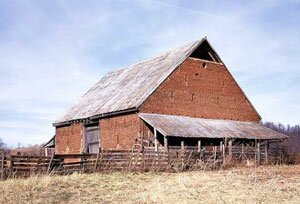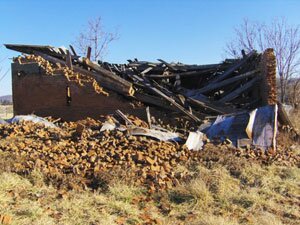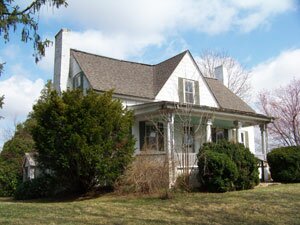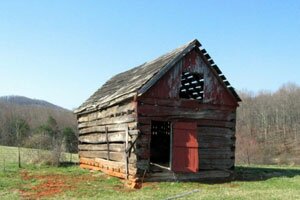ON ARCHITECTURE- Going Down: Sutherland Farm demos wake preservationists


"It looked basically the same until five years ago," says preservationist Steven Meeks of this fallen English ground barn, circa 1810.
PHOTOS COURTESY ACHS
Unlike Charlottesville, which regulates everything from siding choices to paint colors, county historic preservation laws have about as much backbone as a nervous, drunken sheriff in a wild west town. In 2000, a historic preservation plan was adopted, but it has yet to be implemented.
Still, Margaret Maliszewski, the county's historic preservation committee director, says they do their best to track and document historic properties. So when a demolition permit was filed for two barns and the main house at Sutherland Farm (down 29 South near the North Garden fairgrounds), one of a handful of historically significant properties the committee has been watching, the alarm was sounded in the preservation community. Apropos, we'd say, considering this is Preservation Week 2009.
"We have wanted to save the buildings on Sutherland Farm, particularly a barn that has since collapsed," says Maliszewski, "but the whole property is important."
Indeed, according to UVA architectural history professor K. Edward Lay, the main farm house, called Solitude, was built around 1810, and it is alleged that Thomas Jefferson brought his slaves to a doctor there for inoculations.
Lay says he documented the house not long ago, which sits on 457 acres, and believes thr many features that display the era's construction techniques make it worth preserving. (Though Lay notes that the exterior porch, dormer, and asbestos siding came later and can be removed.)
The house has two double-ramped chimneys that exhibit the brickwork of the day, as well as a separate smokehouse and kitchen. It's original owner, Henry Gantt of Maryland, won $40,000 in the Maryland lottery in 1821 and returned home, says Lay, leaving the property to his son Dr. John W. Gantt, presumably the doctor who treated Jefferson's slaves. In 1837, the son sold the property to Joseph L. Sutherland, and it remained in the Sutherland family until it was sold four years ago.
"It's in sound condition and could be fairly easily restored back to its earlier appearance," says Lay, "which I would think would be an added value to the property."
In addition, he says the two log barns remaining on the property are in excellent condition and have some of the very longest logs in the county, about 25 feet.
"The wonderful 1810 brick English ground barn there, which was used to store grain, was badly damaged by a tornado in recent years and has now collapsed," he says.
According to Maliszewski, the farm manager says that the current owner, Boaz Mountain LLC, which bought the place for $6.4 million in 2005, believe the deteriorating structures are making it more difficult to sell the property, which is currently on the market for $6.495 million.
Shortly after purchasing the property, the new owner placed most of its 457 acres under an open space easement with the Virginia Outdoors Foundation, perhaps to keep it from being developed like Bundoran Farm in North Garden. However, the property also has 16 development rights, including 6 on 18 acres of land that cover both sides of Route 29 South.
When asked why the seemingly conservationist-minded owners wanted to demo the historic structures, farm manager Thomas Bradley said, "I can't comment on that, and the owners probably wouldn't either."
So who are the owners? Bradley refused to say. But according to county deed records, Boaz Mountain LLC is a company registered in Texas, with Mark A. Lee listed as manager. Messages were left with the property's listing agent, Jim Faulconer, but he did not respond by press time.
Maliszewski says the owner, via Bradley, is allowing her team to photograph and document the structures before taking them down. She says the Virginia Department of Historic Preservation has also surveyed the property, though it hasn't been designated historic.
Some preservationists aren't taking the news of the demo lightly.
"I'm appalled at this turn of events for this property," says Steven Meeks, president of the Albemarle Charlottesville Historic Society. "We have already lost probably the most historic barn on this property."
Meeks says the collapsed brick barn was the only such structure in the county, and will be featured in the ACHS exhibit on lost Albemarle buildings.
"Due to neglect, it imploded over a year ago," says Meeks, unwilling to lay the blame solely on tornado damage.
"This should be headline news," he adds.
And so it is.

After years of the neglect, Solitude, the circa-1810 main farm house at Sutherland Farm needs considerable work. But UVA architectural history prof K. Edward Lay believes it's a treasure. Indeed, it's alleged that Thomas Jefferson brought his slaves to a doctor who lived in the house.
PHOTO COURTESY K. EDWARD LAY

Lay says two barns remain intact– with, at about 25 feet, some of the longest logs in the county.
PHOTO COURTESY K. EDWARD LAY
#